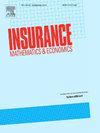风险约束下均值-方差偏好下的最优保险契约
IF 2.2
2区 经济学
Q2 ECONOMICS
引用次数: 0
摘要
本文研究了具有均值-方差偏好的代理人的最优保险安排。为了进行风险管理,代理人的终端财富受到风险值条件的约束。对于可容许的赔偿函数,我们认为它们同时受赔偿原则、激励相容条件和所谓的Vajda条件的约束。Vajda条件规定,在保险合同中,保险公司承担的损失比例应随着总损失金额的增加而不减少。利用非递减重排技术和修正方法,我们的结果表明,最优保险要么是纯免赔保险,要么是在期望值保费原则下具有免赔额的混合比例保险。作为副产物,我们也分别得到了组合保险约束下均值方差偏好、均值var偏好和均值方差偏好下的最优保险策略。最后,我们提出了数值研究,为这些发现提供经济见解。本文章由计算机程序翻译,如有差异,请以英文原文为准。
Optimal insurance contract under mean-variance preference with value at risk constraint
In this paper, we investigate the optimal insurance arrangement for an agent who exhibits a mean-variance preference. For the purpose of risk management, the agent's terminal wealth is constrained via a Value at Risk condition. As for the admissible indemnity functions, we suppose that they are subjected to principle of indemnity, incentive compatibility condition, and a so-called Vajda condition as well. The Vajda condition stipulates that within an insurance contract, the proportion of the loss borne by the insurance company should be non-decreasing as the total loss amount increases. By employing a non-decreasing rearrangement technique and a modification approach, our results show that the optimal insurance is either a pure deductible insurance or a mixed proportional insurance with a deductible under expected value premium principle. As by-products, we also obtain the optimal insurance policies under preferences of mean-variance, mean-VaR, and mean-variance with a portfolio insurance constraint, respectively. Finally, we present numerical studies to provide economic insights into these findings.
求助全文
通过发布文献求助,成功后即可免费获取论文全文。
去求助
来源期刊

Insurance Mathematics & Economics
管理科学-数学跨学科应用
CiteScore
3.40
自引率
15.80%
发文量
90
审稿时长
17.3 weeks
期刊介绍:
Insurance: Mathematics and Economics publishes leading research spanning all fields of actuarial science research. It appears six times per year and is the largest journal in actuarial science research around the world.
Insurance: Mathematics and Economics is an international academic journal that aims to strengthen the communication between individuals and groups who develop and apply research results in actuarial science. The journal feels a particular obligation to facilitate closer cooperation between those who conduct research in insurance mathematics and quantitative insurance economics, and practicing actuaries who are interested in the implementation of the results. To this purpose, Insurance: Mathematics and Economics publishes high-quality articles of broad international interest, concerned with either the theory of insurance mathematics and quantitative insurance economics or the inventive application of it, including empirical or experimental results. Articles that combine several of these aspects are particularly considered.
 求助内容:
求助内容: 应助结果提醒方式:
应助结果提醒方式:


